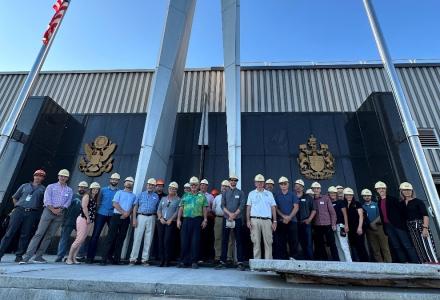
The International Joint Commission’s (IJC) Great Lakes Water Quality Board is investigating current issues and trying to anticipate future problems when it comes to nutrients, the decommissioning of nuclear power facilities, protecting wetlands, and minimizing the impacts from flame retardants as well as climate change. Work also has begun on a new public opinion poll.
The board provides advice to the Commission on issues that can impact the quality of the Great Lakes and recommends approaches to address the problems. Several board work groups are seeking to answer a variety of questions:
How can programs and policies be strengthened to prevent and reduce nutrients from entering the Great Lakes?
The board recently began a project to evaluate how existing regulations, rules, policies and practices in the Great Lakes are applied to the use, management, storage and disposal of manure from animal feeding operations. Manure from these large farms, also called combined animal feeding operations or CAFOs, can contribute pollutants to the lakes, particularly nutrients, depending on the amounts that are land-applied and used as a source of fertilizer in crop production. This project is expected to be complete by the summer of 2018.
The work follows an August 2016 board report that included recommendations on how watershed management plans (plans that outline actions and goals to manage the land, water and resources within a specified area for a healthy ecosystem) should be used to manage nutrient pollution in Lake Erie.
In early 2017, a workshop and webinar were held to further explore the recommendations of this report, by seeking feedback and insights from those involved in watershed planning and implementation. A report on this work is expected in late summer 2017.
Do the processes for closure of nuclear power plants adequately consider potential impacts of future radioactive releases?
The Great Lakes region has a number of nuclear facilities in the area or near the shores. This includes nuclear power plants that are nearing the end of their expected life or being considered for closure or “decommissioning.” By summer 2018, the board hopes to have advice and recommendations on actions needed to eliminate and reduce potential threats to the Great Lakes from the decommissioning of nuclear facilities.
What actions can be taken to achieve a net gain of wetland habitat in the Great Lakes basin?
Wetlands help protect and maintain Great Lakes aquatic ecosystems by filtering pollutants and sediments, storing nutrients, reducing flooding and erosion, and providing food and habitat for fish and wildlife. One of the commitments under the Great Lakes Water Quality Agreement (GLWQA) is to achieve a net gain of habitat, including wetlands. The board is researching the issue to develop recommendations on actions that can be taken to assist in protecting and restoring wetland habitats. The Great Lakes basin has lost 50 percent of its wetlands since settlement began, from agricultural, industrial and residential development. This project is expected to be complete in early 2018.

How are PBDE-containing products handled at their end-of-life and are the actions taken by governments and other institutions adequate to minimize the release of these chemicals to the environment?
Since the 1970s, flame retardants such as PBDEs have been added to a wide range of products including carpeting, mattresses, furniture and electronics, as a means for complying with consumer safety standards. Numerous studies have raised concerns about the persistence of these chemicals in the environment and harmful effects on humans and wildlife. While efforts have been made over the past two decades to phase-out the manufacture of these chemicals, there are still substantial quantities of products containing PBDEs that are used in the Great Lakes basin.
In March 2016, the board produced a report that provided advice on strategies and actions to minimize and prevent the release of PBDEs from the products that contain them. The Commission solicited public comment on the board report in the summer of 2016 and issued a Commission report with recommendations to the governments in November 2016. Further work has been undertaken by the board, by way of a binational workshop last February, to obtain insights from experts on solutions to finding alternatives to using PBDEs and best practices for the end-of-life management of PBDE-containing products. The findings and recommendations from this work are expected to be finished in late summer 2017.
What actions by governments are being undertaken to address climate change impacts? How can these actions and programs be strengthened?
The board released a report in January 2017 on a culmination of activities to answer these questions. Climate change in the Great Lakes is expected to impact the amount, frequency and intensity of storms; increase air and water temperatures; and decrease ice cover. These changes can adversely impact the physical, chemical and biological quality of the Great Lakes ecosystem through intensified erosion, sediment and nutrient loading, loss of wetlands, and loss of fish habitat. The report provides strategies and approaches to adapt to various impacts that climate change will have on the Great Lakes region. The Commission endorsed two board recommendations in its draft Triennial Assessment of Progress report, released in January 2017.
What gaps exist in people’s understanding and awareness of Great Lakes issues and the role that various actors play in protecting them?
The board conducted its first Binational Great Lakes Poll in 2014. The purpose of the poll is to raise awareness about Great Lakes water quality and assess public perceptions about water quality and who is responsible for protecting the lakes. Round two of the poll is planned to occur in late 2017 with the results released in the first quarter of 2018. As with the first survey, the results of round two will be shared with policymakers, media, the public and other stakeholders. Once there is an understanding of where these knowledge gaps exist, specific communication products and messages can be developed to improve awareness and inspire action.





